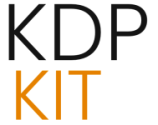Mastering Amazon KDP Cover Sizes for Professional Book Publishing

In the competitive landscape of self-publishing on paperback, or a hardcover. Failing to adhere to these specifications can lead to rejected uploads, poor image quality, or even delays in your book’s launch.
eBook Cover Specifications
For Kindle eBooks, the cover is a single image that appears in the Kindle store and is embedded as the first page of the digital book. The visual impact of an eBook cover is magnified due to its prominence in online browsing.
Dimensions and Resolution
KDP recommends specific dimensions for eBook covers to ensure optimal display on various Kindle devices and the Kindle app. The ideal dimensions are 2560 pixels in height by 1600 pixels in width. For the best quality, especially on high-definition devices, an image with a height of 2500 pixels is also recommended.
The minimum dimensions for an eBook cover are 1000 pixels in height by 625 pixels in width. However, it’s crucial to use the recommended dimensions to avoid potential quality degradation when Amazon applies its own compression.
The aspect ratio should be at least 1.6:1, meaning for every 1000 pixels in width, the image should be 1600 pixels in height.
Regarding resolution, a minimum of 300 DPI (dots per inch) or PPI (pixels per inch) is required for clarity and sharpness.
File Format and Size
The preferred file format for eBook covers is JPEG (.jpeg/.jpg). TIFF (.tif/.tiff) is also supported, but JPEG generally results in smaller file sizes, which are beneficial for uploads.
The file size for eBook covers must be 5MB or fewer. While KDP may apply additional compression, it’s best to upload images with minimal compression to maintain quality.
Color Mode
For eBook covers, the color mode should be RGB (Red, Green, Blue). Kindle does not support CMYK.. Find out more about Amazon KDP cover size requirements.
Paperback and Hardcover Cover Specifications
Print covers for paperbacks and hardcovers are more complex as they involve a full wrap-around design, including the front cover, spine, and back cover. These require precise calculations based on trim size, page count, and paper type.
Trim Size and Page Count
KDP offers a variety of standard trim sizes for both paperbacks and hardcovers. The choice of trim size significantly impacts the overall cover dimensions and the width of the book’s spine.
Common paperback trim sizes include:
- 5″ x 8″
- 5.5″ x 8.5″
- 6″ x 9″ (a popular industry standard)
- 7″ x 10″
- 8.5″ x 11″
Hardcover trim sizes include:
- 5.5″ x 8.5″
- 6″ x 9″
- 7″ x 10″
- 8.25″ x 11″. Find out more about Kindle eBook cover dimensions 2025 guide.
The page count of your book is a critical factor in determining the spine width. For paperbacks, the minimum page count for spine text is typically 79 pages.
Spine Width Calculation
The width of the book’s spine is calculated based on the page count and the type of paper used. KDP provides formulas for this calculation:
- White paper: Page count × 0.002252 inches
- Cream paper: Page count × 0.0025 inches
- Premium Color paper: Page count x 0.002347 inches
- Standard Color paper: Page count x 0.002252 inches
These calculations determine the exact width needed for the spine on your cover wrap. Many online tools and KDP’s own cover calculator can assist with these precise measurements.
Bleed Requirements
Bleed is a crucial printing term that refers to extending design elements (like images or background colors) beyond the final trim edge of the page. KDP requires a 0.125-inch (3.2 mm) bleed on all four edges of your cover file. This ensures that when the book is trimmed to its final size, no white edges appear, and your design extends fully to the edge.
Safe Margins
To prevent important text or design elements from being cut off during the trimming process, KDP specifies safe margins. Text and critical design elements should be kept at least 0.25 inches from the edges for books without bleed, and 0.375 inches (9.6 mm) from the edges for books with bleed. For the spine, ensure text is placed within a safe area, typically with at least 0.0625 inches (1.6 mm) of space on either side to prevent it from wrapping onto the front or back cover.
File Format and Resolution for Print
Print covers must be uploaded as a single PDF file that includes the front cover, spine, and back cover as one continuous image. The preferred PDF standard is PDF/X-1a or PDF/A, with all fonts embedded.. Find out more about Paperback book cover bleed 0.125 inches tips.
The resolution requirement for print covers is a minimum of 300 DPI/PPI. Using high-resolution images and vector-based elements is recommended to maintain clarity and sharpness.
Color Mode for Print
For print covers, the preferred color mode is CMYK (Cyan, Magenta, Yellow, Black). While designs may originate in RGB, conversion to CMYK is necessary for accurate printing. Be aware that color shifts can occur during conversion, so careful proofing is advised.
Key Design Considerations and Best Practices
Beyond the technical specifications, several design principles can significantly enhance your book cover’s effectiveness:
1. Stop the Scan
In the crowded Amazon marketplace, your cover must immediately capture attention. Use strong visuals, clear typography, and a color scheme that stands out from competitors while remaining genre-appropriate.
2. Clarity and Simplicity
Avoid overcrowding your cover with too many elements or fonts. A clean, uncluttered design conveys professionalism and makes the title and author’s name easily readable, even as a small thumbnail.
3. Genre Appropriateness
Readers expect certain visual cues from different genres. Ensure your cover design aligns with the conventions of your book’s genre to set the right expectations.
4. Spine Text
If your book has 79 or more pages, include your title and author name on the spine. Ensure this text is legible and correctly positioned within the safe margins.
5. Barcode Placement
KDP automatically adds a barcode to the back cover of print books. Ensure there is adequate clear space on the back cover for this barcode, typically in a designated area, to prevent it from obscuring important design elements or being distorted.. Find out more about Hardcover book spine width calculation strategies.
6. Using KDP Tools
KDP offers a Cover Creator tool that can assist in designing basic covers that meet specifications. Additionally, KDP provides a Cover Calculator and downloadable templates to help you accurately size your cover files.
7. Preview and Proofread
Always use KDP’s previewer tool before publishing to check for any alignment, cropping, or color issues. Double-checking all details ensures a polished final product.
Common Mistakes to Avoid
- Incorrect Dimensions: Failing to match KDP’s exact size requirements can lead to rejection or poor image quality.
- Ignoring Bleed: Not including the 0.125-inch bleed can result in white borders on the final printed book.
- Low-Resolution Images: Upscaling low-resolution images will inevitably lead to pixelation.
- Incorrect File Format or Color Mode: Using the wrong format (e.g., SVG for eBooks) or color mode (CMYK for eBooks) can cause upload errors or incorrect color reproduction.
- Overcrowded Design: Too many elements can make the cover look unprofessional and difficult to read.
- Forgetting Spine Text: Not including spine text on books with sufficient pages, or placing it incorrectly, can be an issue.
- Not Using Safe Margins: Placing crucial elements too close to the edges can lead to them being cut off.
Conclusion
Creating a book cover that meets Amazon KDP’s specifications is a vital step in the self-publishing journey. By understanding the precise dimensions, file formats, bleed requirements, and safe margins for both eBooks and print books, authors can ensure their covers are professional, appealing, and compliant. Utilizing KDP’s provided tools and adhering to best design practices will not only streamline the publishing process but also significantly contribute to your book’s visibility and sales success in the competitive Amazon marketplace.






